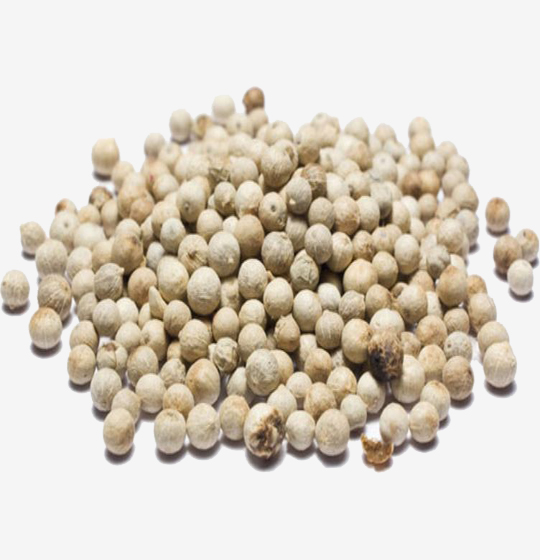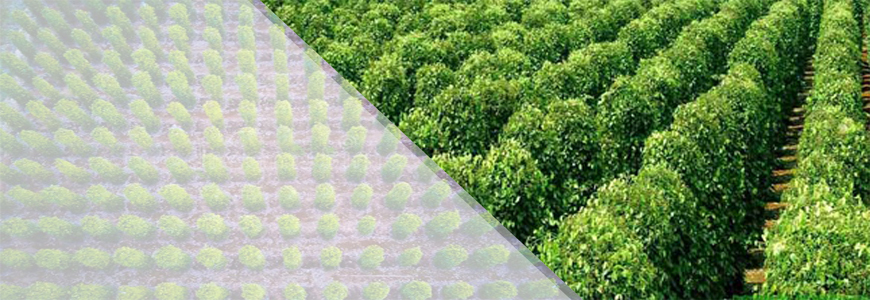
WHITE PEPPER:
Grade: White Pepper 630 G/L Double Washed, White Pepper 630 G/L.
Standard: FAQ, ASTA, CLEAN MACHINE, DOUBLE WASHED, etc.
Colour: White
Moisture: max 12.5%, Admixture 0.1%
Packaging: 20kg - 50kgs/bag or kraft bag | 17 tons in 20 FCL/ 28 tons in 40 FCL
Vietnam produces a variety of pepper types, which are all pegged on the ripening stages of the piper nigrum plant. These berries, which have cluster-like shape, keep changing colors in the steps of ripening. They start initially from green to yellowish or yellow-orange color and later on ends up as pure red, which is at a full maturity stage. Typically, the green phase of the berries is unripe, while the yellowish or yellow-orange or orange-red stage shows that the berry is fully ripe. Based on the maturity level of the berries or the color level when they are harvested, a Vietnam farmer can produce green pepper, black pepper or red pepper, including white pepper as discussed below:

Black pepper is obtained from the green, unripe berries of the pepper plant. The Vietnamese farmer cooks the drapes for a
short time in hot water. This is a process that aims at cleaning the drapes and getting them ready for drying. The hot water
is mainly used to rupture the drapes wall cells, which activates the browning process that ends up increasing the time of
browning during drying.
The drapes are mostly dried in the sun or by the use of a drying machine. During this process, the pepper skin that enwraps
the drapes skin darkens into a thin, crinkly black coat. At the stage where the drapes are thoroughly dried, they are referred to as the black peppercorn.
Some farmers may consider harvesting the berries from the plant by hand and going ahead to sun dry them without any need to boil them.
At the stage where the peppercorns are thoroughly dried, it is possible to extract oil and spirit from the berries by crushing them by hand
or by using a particular machine. Many manufacturers of beauty products and medicine find the pepper spirit useful. Besides, the pepper oil helps
in the production of special ayurvedic massage oil that is used in beauty products as well as herbal medicine.
The white pepper entails mainly the seed of the ripe berry of the pepper plant. Its thin darker color skin is often peeled.
The removal of the skin of these berries is done through a process that is referred to as retting, where the wholly ripened
red pepper fruits are soaked in water for approximately a week or so. In this regard, the skin of the peppercorn becomes soft
and crumbles. The berries are then rubbed, which removes any remaining skin. The seed is then dried to remove the water and
moisture content from the soaking. In some cases, other processing ways are applied to help with the removal of the skin of
the pepper from the seed. This also entails extracting the seed from the skin through a mechanized process or a chemical or biological means.
Ground white pepper is applied in many Asian meals, including countries like China, Thailand, and Portugal. It is also used in salads,
mashed potatoes, and sauces. In potatoes, the white pepper is ideally desired because black pepper would stand out too much than required.
White pepper is characterized by unique compounds found in the drupe's outer layer, which helps to create a distinctive flavor..
If star anise fruits are not picked at the right time, the trees will not produce more flowers next year.
Green pepper, similar to black pepper, is prepared from unripe drupes. The farmers dry the green peppercorns in a unique way
that helps with retaining the green color and texture, for example, with sulfur dioxide, canning, or freeze-drying. Pickled
peppercorns, which are as well green, are unripe drupes that are preserved in vinegar or brine.
The fresh, green pepper drupes often unpreserved are mostly uncommon in the West of Asia, but they are primarily used in many
Asian dishes, specifically in Thai cuisine. Their flavor has been the most sought-after because they are believed to be perfectly
spicy and super fresh. Some find it great because it has a bright aroma. They also decay fast even without drying or preserving,
which makes them somewhat unsuitable for exports in Vietnam compared to the other types of pepper.
These are typically red peppercorn drupes that are preserved in vinegar and brine. The ripe red peppercorns can be dried using similar color preservation approaches that are used to process the green pepper.
These are fruits or berries that come from the Peruvian pepper tree or Schinus molle. These are part of the cashew family. They are known to bring about allergic responses, such as anaphylaxis, to people with nut allergies.
Mainly, the pepper tree in Vietnam was first introduced from India, as Piper nigrum under the Piperaceae Family. It was introduced to Vietnam back in the 17th century by the French. It was grown particularly in several regions in Vietnam, including Phu Quoc, Ha Tien (Kien Giang, and Hon Chong, which was in the 9th century. The planting of the pepper plant continued throughout the country, especially in the Southeastern regions and the Central regions in the 20th century. During this time, the pepper plant's cultivation was not very common, as about 400ha was left for growing pepper trees that led to approximately 500 tons of crop yield back in the 1970s.
Presently, pepper trees are grown in 6 specific provinces of Vietnam: about 12,48 ha in Binh Phuoc, about 11,154 ha in Dak Nong, about 12,082 ha in Dak Lak, 9,074 in Ba Ria-Vung Tau, about 9,010 ha in Dong Nai, and finally 11,245 ha in Gia Lai. Among these six regions for the growth of pepper, both the southeastern and central areas are ranked as the leading when it comes to the scope and levels of production. Vietnam has other regions that are still known for the growth of pepper, Kien Giang, and Phu Quoc, which has created a mark in the export pepper market in Vietnam, including Quang Tri.
Pepper production in Vietnam is tedious but less costly because of ready labor, increased mechanization, and resources, such as processing tools.
Pepper berries grow on pepper bushes, which are cultivated to heights of approximately 13 ft. or four meters. Supposing these berries were left to ripen fully, they would become red. However, they are mostly harvested (often without a mechanical tool) when they are still green. On the same note, women pick the unripe berries and carry them in large wicker baskets to drying places, where they spread them to dry in the sun for about 1 week or so. Upon drying thoroughly, the berries darken and turn into peppercorns used in pepper mills.
The berries can also be harvested as soon as they turn red and boiled for about 10 minutes until they turn dark brown (blackish). They are also dried under the sun for about 3-4 days, and later taken to factories for milling.
In the case where white pepper is produced, peppercorns are stored following boiling. They could also be harvested and packed directly in large sacks and lowered into running streams of water for about 15 days. Bacterial action helps to crumble the skin, forcing it to break away from the seed. The berries are picked and placed in barrels with water, where they are further agitated to remove any pending husks. Machines can be used to grind off the skin, but some exporters have a preference for traditional methods.
Factories use specialized machines to help with processing, such as gravity machines, to remove dust and grit. Sometimes bacteria are removed by special treatment. Packaging and storage are done by grading the size of the grinds. Different processing plants package differently-some package in boxes, others in bags, canisters, jars, or cans.
Vietnam has been a leading exporter of pepper to foreign markets, leaving behind many competitors in the market. With consistent quality and technological growth, Vietnam has continued to rank at the top when it comes to pepper exports. This explains why so many countries ate, showing a steady demand for its high-quality pepper product.
Vietnam has continued to see the level of growth of pepper tripling over the years. The export rates are by far toppling that of its immediate competitors, such as Brazil, Indonesia, India, Malaysia, and Sri Lanka, who lag far behind.
Vietnam embarked on producing pepper for export as echoed by the declining global price for coffee, which was another leading export product in Vietnam. This is also in view of the rising demand from the global food-processing industry, for high-quality black pepper as well as exotic spices that Vietnam is ready to offer in large amounts. This is counting on the fact that many Asian people love different types of pepper, which add up to the spices in dishes they prepare and serve. Moreover, Vietnam pepper continues to show a likelihood of increased profitability in the coming years, as weighed against other types of products, such as cashew.